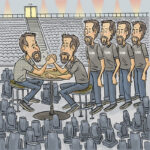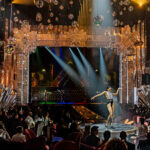When I was a young man, I toured with the Talking Heads. They were a "new wave" band with a big following and a light show that was out of the ordinary. The show consisted of all white light – no gels, except for one song where the rear cyc turned red, and all tungsten fixtures except for one HMI 2.5k fixture we used once. Wherever we went, there was always some older stagehand who would question what we were doing at the time and then remark, "Well, I guess we just did it differently in my day." Now it's 30 years later and I am starting to wonder if I am that old guy questioning how shows are lit today…I recently found myself at the Country Music Awards in Nashville. My artist was playing the same hit single…But I was disturbed as I look at the camera monitors. The levels of the strip lights are so hot that they are creating white flares on the camera. As the cameras flare, the iris on them automatically dials down to compensate. Now my artist is looking very dark and needs more light. But this is what rehearsals are for. Surely someone in the TV truck will notice this and dial the levels down for the show. Then come the strobe cues. They appear to be full on, max power. My entire monitor turns into a snow blizzard. I imagine this has been noticed as well. I look to a wide shot monitor and notice that my entire 10-piece band has no front light. I obviously have not kept up with the latest in television lighting methods – no front light except on the main artist, and it's now acceptable to blind the cameras. People must like this…The cameras are wiped to white. It's ruining an otherwise beautiful piece of music. My band comes on 20 minutes later and everything I assumed would be fixed hasn't been. It looks bad, but it must be me. I realize now that I have become the old man who doesn't understand this new change in lighting theory.
-From "LD-at-Large" by Nook Schoenfeld, PLSN, Jan. 2011


